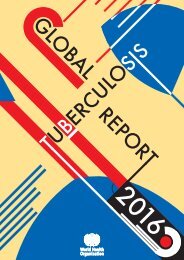patients
DNDi_AR_2015
DNDi_AR_2015
You also want an ePaper? Increase the reach of your titles
YUMPU automatically turns print PDFs into web optimized ePapers that Google loves.
STRENGTHENING EXISTING CAPACITIES<br />
HUMAN AFRICAN<br />
TRYPANOSOMIASIS (HAT)<br />
PLATFORM<br />
Founded: 2005 in Kinshasa, Democratic Republic of the Congo<br />
Over 120 individual members, representing over 20 institutions<br />
2015 HIGHLIGHTS<br />
• Recruitment of <strong>patients</strong> to the fexinidazole Phase II/III study completed (394 <strong>patients</strong>)<br />
• Participation in the 33 rd International scientific council of research and control of<br />
trypanosomiasis in Ndjamena, Chad, with 53 attendees (Sept.)<br />
Dem. Rep.<br />
of the Congo<br />
Rep.<br />
of Guinea<br />
Rep. of<br />
the Congo<br />
Angola<br />
Chad<br />
Sudan<br />
South<br />
Sudan<br />
Central<br />
African<br />
Republic<br />
Uganda<br />
The HAT platform builds<br />
and strengthens treatment<br />
methodologies and clinical trial<br />
capacity in sleeping sicknessendemic<br />
countries, so that new<br />
treatments for this fatal disease<br />
can be rapidly and effectively<br />
evaluated, registered, and made<br />
available to <strong>patients</strong>. After the<br />
success of Nifurtimox-Eflornithine<br />
Combination Therapy (NECT),<br />
included in the WHO List of<br />
Essential Medicines for the<br />
treatment of stage 2 HAT, the<br />
primary goals of the HAT Platform<br />
have been to develop appropriate<br />
clinical trial methodologies for<br />
sleeping sickness, overcome<br />
system challenges related to<br />
administrative and regulatory<br />
requirements, strengthen clinical<br />
trial capacity (human resources,<br />
infrastructure, equipment), and<br />
share information and strengthen<br />
ties between endemic countries.<br />
Treatments & Access<br />
In 2015, NECT improved therapy has been used<br />
as first-line treatment for stage 2 sleeping<br />
sickness in almost all T. b. gambiense detected<br />
<strong>patients</strong>. The platform attended the meeting<br />
of the Consultative Scientific Committee to<br />
the national control programme of DRC in<br />
Kinshasa, DRC (Sept.), where the DRC national<br />
HAT policy was reviewed and recommendations<br />
were issued. This could help other national<br />
programmes to revise and update their policies,<br />
particularly considering WHO’s new target for<br />
elimination of the disease by 2020.<br />
Clinical trials<br />
• Fexinidazole Phase II/III study: Inclusion<br />
of all 394 <strong>patients</strong> completed in April. Two<br />
additional cohort studies have enrolled the<br />
following: 230 stage 1 and early stage 2 adult<br />
<strong>patients</strong> and 125 children aged 6-14 years<br />
(all stages). A total of 749 <strong>patients</strong> have been<br />
included.<br />
• SCYX-7158 Phase II/III study: This single<br />
dose oral treatment will be tested in<br />
210 stage 2 and around 150 stage 1 <strong>patients</strong><br />
in DRC. Recruitment is planned to start in<br />
2016. Three new clinical sites, N’gandajika,<br />
Bolobo, and Kwamouth (DRC), were selected<br />
and prepared in 2015.<br />
Capacity strengthening<br />
Training on Trypanosomiasis management was<br />
co-organized between Chad’s national sleeping<br />
sickness control programme and the HAT<br />
Platform in Dinamadji district (Chad) with the<br />
support of DRC national control programme;<br />
22 doctors and nurses attended (August). The<br />
platform also supported HAT clinical training<br />
in South Sudan, with 36 attendees (Nov). An<br />
investigators’ meeting on fexinidazole trials was<br />
organized in Kinshasa, DRC, with 18 attendees<br />
(July).<br />
Communications<br />
The 16th edition of the HAT Platform newsletter<br />
was published in 2015.<br />
“The training in Good Clinical<br />
Practice and the site initiation of<br />
the clinical study help me on a<br />
daily basis to improve the way<br />
we take care of all <strong>patients</strong>.“<br />
Tawaba Say Watson,<br />
Nurse head, Bagata,<br />
Kwilu province, RDC<br />
MEMBERS: National sleeping sickness control programmes and national laboratories of public health of the most<br />
affected endemic countries: Angola, Central African Republic, Chad, Democratic Republic of the Congo, Guinea,<br />
Republic of Congo, South Sudan, Sudan, Uganda; Drugs for Neglected Diseases initiative (DNDi), Switzerland; Swiss<br />
Tropical and Public Health Institute (Swiss TPH), Switzerland; Institute of Tropical Medicine – Antwerp, Belgium; Institut<br />
de Recherche pour le Development (IRD), France; Institut National de Recherche Biomédicale (INRB), DRC; University<br />
of Makerere, Uganda; Kenya Agricultural Research Institute – Trypanosomiasis Research Centre (KARI-TRC), Kenya;<br />
Tropical Medicine Research Institute (TMRI), Sudan; University of Juba, South Sudan; Institut Pasteur Bangui, CAR;<br />
Médecins Sans Frontières (MSF); Foundation for Innovative New Diagnostics (FIND), Switzerland; Eastern Africa<br />
Network for Trypanosomosis (EANETT), Centre interdisciplinaire de Bioéthique pour l’Afrique Francophone (CIBAF), INZI<br />
project, University of Edinburgh, UK; WHO Department of Neglected Tropical Diseases as observer.<br />
DNDi Annual Report 2015 › 59



